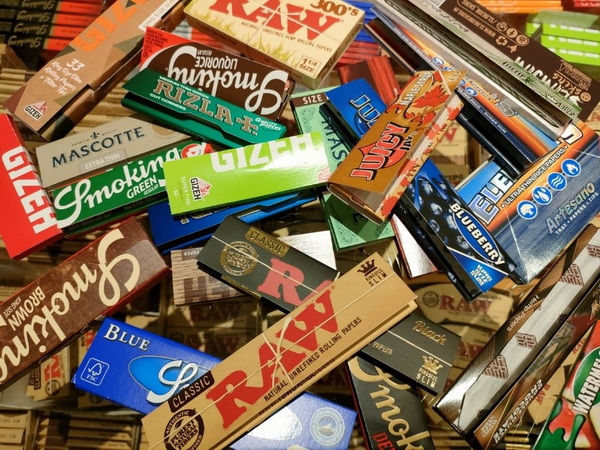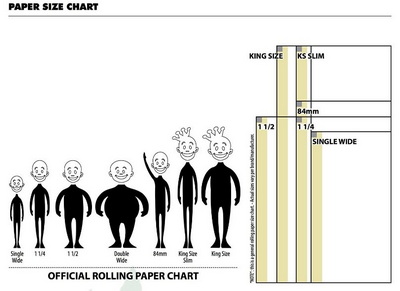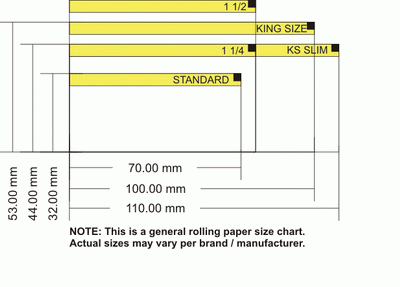
Rolling Paper Buying Guide
A rolling paper, which may be referred to as a blank or joint paper, is a sheet of thin paper made from either wood or plant materials that is used to roll herb for smoking. The papers usually come with a thin strip of adhesive along one edge to seal off the joint after rolling and can have various attributes depending on the manufacturer.
Common Characteristics of Rolling Papers
If you've ever stepped into a smoke shop, you'll know that there are hundreds (if not thousands) of rolling papers on the market, and they all claim to offer something unique. And while they might all look similar, rolling papers can vary quite significantly. Some notable characteristics that might impact your buying decision when it comes to choosing a rolling paper include size, flavor, style/form, and color/design.

The Length of cigarette is 84-85 mm.
Size
Rolling papers typically come in the following pre-cut sizes:

- Single Wide Rolling Paper (SW) /Single/ Regular/ Standard Rolling Papers are 70mm long and 38 mm wide, which makes them about 2.75 x 1.4 inches in size - the size of a typical cigarette for most people's enjoyment holding up to 0.5g of material!
- 1 ¼ Rolling Papers are a popular choice among many, as they can hold up to 25% ie. a quarter more (about 0.75g of material) than their single-wide counterparts. They are usually about 78mm long and 48mm wide. This is the most popular form of smoking Size
- King Size rolling papers are the longest size commercially available and measure 110mm x 44mm
2. Most Common Rolling Paper Materials
Below is a breakdown of the most common materials used to create rolling papers. Some are more popular than others, and some are subject to significant chemical treatment while others are kept relatively unprocessed. Furthermore, each type of paper has a slightly different burn rate and porosity.

- Classic Wood Pulp Paper
At one point in history, wood pulp rolling papers were among the most popular, and they continue to be used to this day. They are often mixed with other fibres, giving them a texture makes them easy to handle. On average, these papers are thicker than other, newer types, even if they are available in a few different thicknesses—bleached or unbleached. White wood pulp papers are bleached, while brown ones are not. Wood pulp is solid, and the handy texture of these papers makes them convenient for beginners because they hold their shape well, even in presence of a little humidity or shaky, sweaty hands. Wood pulp papers have a medium–fast burn rate and are considered less desirable among most smokers compared to other materials.

- Rice Paper
The best rice papers are made from all-natural ingredients, meaning it’s basically just processed and pressed rice. These rolling papers are usually thinner than others, which is a good thing for your lungs but may require a little more effort when rolling. This smooth paper might not grip well between your fingers and is pretty vulnerable to certain conditions, especially damp air. Forget smoking with these papers when it’s raining outside. Rice paper is thin yet burns slowly. The little material used for a single sheet makes it a potentially better choice for your health, and for enjoying your weed without almost any external aftertaste.

- Flax Paper
A similar result can be achieved with flax, which is sometimes used in rolling paper blends. There are indeed rolling papers made from 100% flax that can be considered a nice alternative to rice papers. The flax plant is well-known for producing flax seeds, a highly nutritious food that can be processed into a rich oil with a load of potential benefits. Flax fiber is made from the plant's natural long stems, and can be processed into a durable, lightweight, and ultra-fine paper. While they're not super popular, flax papers have a unique, silky texture that feels great in the hands and makes for easy rolling. Flax papers burn nice and slowly, giving you more time to enjoy your smoke, and are also flavorless, meaning they won't impact or alter the flavors/aromas of your herb in any way.

- Hemp Paper
Industrial hemp has proudly resurged in the last 20 years, and hemp rolling papers were immediately appreciated by the community. First off, these papers help to save trees, as they are made from hemp fiber, not wood pulp. Their color is mainly light brown because the bleaching process is usually not appreciated by cannabis consumers. Hemp papers are thicker and rougher than rice ones, providing a good grip when rolling. However, they have a similar tendency to absorb (and eventually release) humidity. They have a medium burn rate and go out less often than rice papers. Joints made with hemp papers might take on a delicate aftertaste that won't spoil the aroma of the burning herb.
3. Paper Thickness
If you want to avoid the rolling paper burning faster on the side (also called canoeing) when smoking, thinner weed rolling papers are your best bet. They allow for a slower burn that prevents hot spots and ensures even distribution of smoke in the joint shaft. But beware, thinner paper can be harder to roll (and more expensive) than regular hemp paper so it might take some extra effort in preparation.
Whether you're just starting with weed or have been smoking for years, rolling papers are an essential part of your smoking experience. There's a lot to consider when picking the right paper and we hope this article has helped guide you in the process. The best choice is going to depend on what type of smoker you are as well as how often you smoke.
Shop Rolling Papers in Bangkok Thailand
- Online Site
- Rolling Papers Shop at Seacon Square Srinakarin Bangkok
Tel: 086-6693009
E-mail: vapourhouse@yahoo.com
LINE ID: @vapourhouse
Facebook: vapourhouseshop
